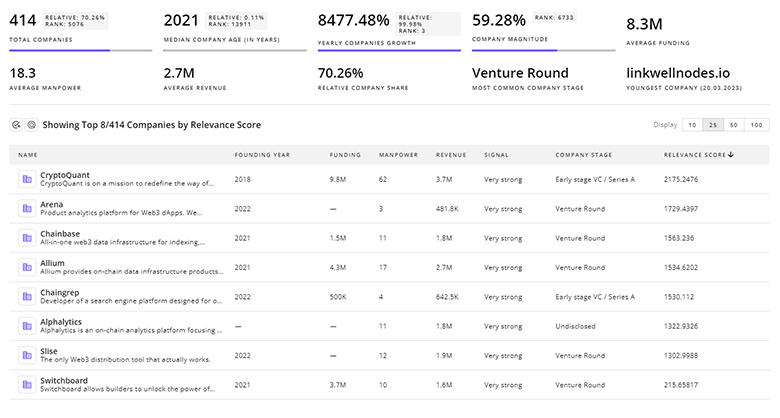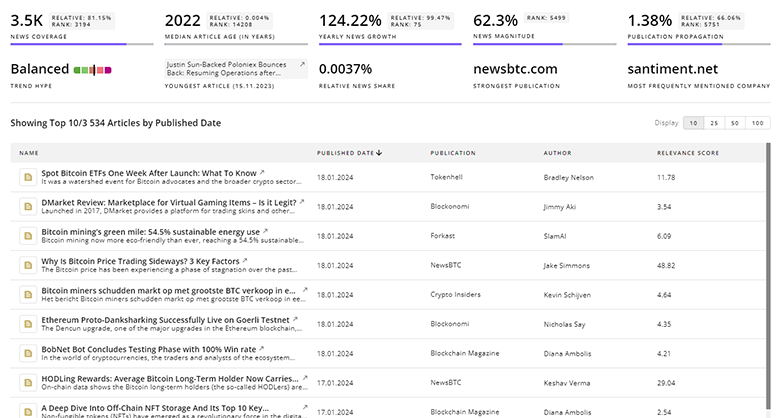
Clinical Med Tech Report
: Analysis on the Market, Trends, and TechnologiesThe clinical med tech sector is shifting from point innovations to integrated, data-centric platforms, driven by a sharp rise in digital and AI activity and measurable IP growth — patent filings increased 35% between 2021 and 2023, signaling intensified R&D intensity and monetizable pipelines. Venture and market signals show concentration at scale (mega funding rounds and platform deals) while market forecasts point to large addressable opportunity in AI-enabled devices and chronic-care platforms (emerging medical device market projected to grow toward $223.9B by 2029) bccresearch.com. Investors focus capital into fewer, larger rounds (42 rounds > $100M in 2024), which concentrates power with platform providers and raises the bar for specialists seeking scale jpmorgan.com.
We updated this report 33 days ago. Noticed something’s off? Let’s make it right together — reach out!
Topic Dominance Index of Clinical Med Tech
The Topic Dominance Index trendline combines the share of voice distributions of Clinical Med Tech from 3 data sources: published articles, founded companies, and global search
Key Activities and Applications
- AI-enabled clinical decision support and diagnostic automation — deployment across imaging, pathology, and perioperative workflows to speed interpretation and reduce manual review time; this activity maps directly to patent trends in computer-aided diagnosis and health-index algorithms.
- Remote patient monitoring (RPM) and hospital-at-home services — multi-parameter wearables and cellular telemetry patches enable continuous chronic-care management and post-acute monitoring, reducing readmissions and enabling reimbursement models for RPM.
- Integrated device + services bundles — device manufacturers expand into HCP education, inventory management, reimbursement support, and workflow consulting to lock in customers and create recurring revenue streams.
- Interoperability, EHR integration and secure data exchange — projects focus on device-to-EHR streaming, FHIR integration, and consented data flows to enable platform value and regulatory compliance.
- Trial acceleration and inclusive recruitment platforms — AI for patient matching and trial operations addresses rising regulatory emphasis on diversity and faster enrollment.
Emergent Trends and Core Insights
- Generative and applied AI moves into production workflows — pilots turn into operational systems that cut administrative time (reports of 20–30% time savings in documentation) and improve throughput in diagnostics, changing buyer expectations for ROI and adoption speed.
- Funding concentration and platform consolidation — investors back fewer, larger rounds, creating scale advantages for platform aggregators and intensifying M&A interest in high-value specialists.
- Supply-chain and operational resilience focus — CEOs prioritize redundancy and simulation; companies deploy digital twins and near-real-time analytics to reduce downtime and procurement risk.
- Commercialization via services — device vendors compete by adding non-device revenue (training, reimbursement, inventory), shifting procurement decisions from pure capital purchases to bundled service contracts iqvia.com.
- Sustainability and equity as contract levers — health systems and regulators increasingly require emissions data and inclusive trial design; compliance becomes a market entry condition in parts of Europe and the U.K.
Technologies and Methodologies
- Machine learning for imaging and pathology — deep-learning models reduce reading variance and speed lab workflows; commercial AI pathology platforms integrate into LIS/APLIS workflows researchandmarkets.com.
- Edge and cellular-connected wearables — on-device analytics and cellular patches minimize latency and smartphone dependence for continuous monitoring use cases databridgemarketresearch.com.
- Cloud platforms, FHIR integration and real-time EHR streaming — these enable cross-vendor data aggregation and near-real-time clinical decisioning.
- Digital twin simulation for supply-chain and equipment management — used to model production and logistics risk and to plan redundancy investments bain.com.
- Blockchain and immutable logging for trial data and consent — applied selectively to improve provenance and auditability in multi-site trials and data marketplaces.
Clinical Med Tech Funding
A total of 20.3K Clinical Med Tech companies have received funding.
Overall, Clinical Med Tech companies have raised $1.7T.
Companies within the Clinical Med Tech domain have secured capital from 85.2K funding rounds.
The chart shows the funding trendline of Clinical Med Tech companies over the last 5 years
Clinical Med Tech Companies
- Techcyte — Techcyte builds an AI pathology platform that digitizes slide workflows and embeds ML models into lab operations to accelerate diagnosis and reduce manual review. The company partners with scanner vendors and labs to scale model deployment and integrates with laboratory workflows to deliver measurable time and accuracy gains.
- Carematix Inc. — Carematix offers modular medical-grade IoT devices and a virtual trials and RPM platform focused on high-quality signal capture (BP, SpO2, glucose) and analytics for population health programs; its model targets lower-cost, scalable monitoring for chronic disease management and trial endpoints.
- TransformativeMed — TransformativeMed develops clinician-focused workflow modules that reduce clicks and standardize care pathways inside the EHR; their disease-specific "cores" aim to cut documentation time and reduce workflow variability at the point of care.
- MobilDrTech — MobilDrTech supplies end-to-end telemedicine hardware and integration services (telemedicine carts, exam cameras, connected stethoscopes) for hospitals and remote clinics; the firm fills infrastructure gaps where turnkey telehealth hardware and compliance are priorities.
Gain a better understanding of 100.3K companies that drive Clinical Med Tech, how mature and well-funded these companies are.

100.3K Clinical Med Tech Companies
Discover Clinical Med Tech Companies, their Funding, Manpower, Revenues, Stages, and much more
Clinical Med Tech Investors
Gain insights into 40.4K Clinical Med Tech investors and investment deals. TrendFeedr’s investors tool presents an overview of investment trends and activities, helping create better investment strategies and partnerships.

40.4K Clinical Med Tech Investors
Discover Clinical Med Tech Investors, Funding Rounds, Invested Amounts, and Funding Growth
Clinical Med Tech News
Gain a competitive advantage with access to 107.3K Clinical Med Tech articles with TrendFeedr's News feature. The tool offers an extensive database of articles covering recent trends and past events in Clinical Med Tech. This enables innovators and market leaders to make well-informed fact-based decisions.

107.3K Clinical Med Tech News Articles
Discover Latest Clinical Med Tech Articles, News Magnitude, Publication Propagation, Yearly Growth, and Strongest Publications
Executive Summary
Clinical med tech sits at an inflection where AI, connected devices, and platform economics intersect. Patent activity and funding patterns show clear investor preference for scalable platforms that bundle devices, analytics, and services. Providers reward solutions that reduce operational friction, integrate with EHRs, and demonstrate short-term ROI in workflows or readmission reduction. For specialists, the path to commercial survival runs through demonstrable clinical value, tight integrations with dominant platforms, or clear, non-replicable data assets that justify standalone adoption. Companies that pair clinical evidence with easy-to-consume commercial models (service bundles, subscription RPM, integrated billing workflows) will capture the earliest adoption waves; those that do not align with platform consolidation risk being relegated to price-competitive commodity status.
We seek partnerships with industry experts to deliver actionable insights into trends and tech. Interested? Let us know!












